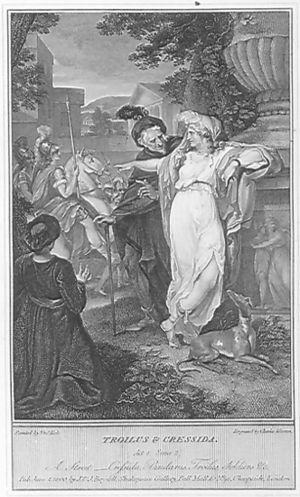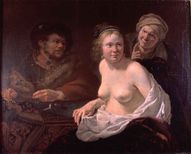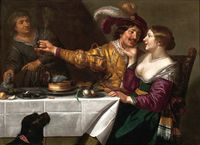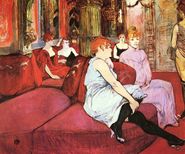Procuring (prostitution)
Procuring or pandering is the facilitation or provision of a prostitute or other sex worker in the arrangement of a sex act with a customer. A procurer, colloquially called a pimp (if male) or a madam (if female) or a brothel keeper, is an agent for prostitutes who collects part of their income. The procurer may receive this money in return for advertising services, physical protection, or for providing, and possibly monopolizing, a location where the prostitute may engage clients. Like prostitution, the legality of certain actions of a madam or a pimp vary from one region to the next.
Examples of procuring include:
- trafficking a person into a country for the purpose of soliciting sex
- operating a prostitution business
- transporting a prostitute to the location of their arrangement
- deriving financial gain from the prostitution of another
Overview
Pimps and madams are diverse and variegated, depending on the strata in which they work, and they enter and leave the sex industry for a variety of internal and external reasons, such as family pressure, interactions with the police, and in some cases recruitment from peer sex workers.[1][2][3]
Procuring can take abusive forms. Madams/pimps may punish clients for physical abuse or failure to pay, and enforce exclusive rights to 'turf' where their prostitutes may advertise and operate with less competition. In the many places where prostitution is outlawed, sex workers have decreased incentive to report abuse for fear of self-incrimination, and increased motivation to seek any physical protection from clients and law enforcement that a madam/pimp might provide.
The madam/pimp–prostitute relationship is often understood to be abusive and possessive, with the pimp/madam using techniques such as psychological intimidation, manipulation, starvation, rape and/or gang rape, beating, confinement, threats of violence toward the victim's family, forced drug use and the shame from these acts. Recent empirical research of madams/pimps, however, suggest that these assumptions about abusive relationships represent stereotyped oppression narratives that may only represent a small percentage of the relationships between madams/pimps and sex workers.
In the U.S., madams/pimps can be arrested and charged with pandering and are legally known as procurers. This, combined with the tendency to identify pimping with African-American masculinity, may provide some of the explanation for why approximately three-fifths of all "confirmed" human traffickers in the United States are African-American men.[4] In fact, it has recently been argued that some of the extreme examples of violence cited in the article below come primarily from such stereotyping supported by Hollywood screenwriters, selective and decontextualized trial transcripts, and studies that have only interviewed parties to sex commerce in institutions of rescue, prosecution, and punishment, rather than engaging rigorous study in situ.[5]
Legal status and debates about legality
Where prostitution is decriminalized or regulated, procuring may or may not be legal. In jurisdictions where procuring is allowed, however, the forms permitted do not involve threats or other forms of non-consensual acts towards the prostitute or other persons; all procuring regulations differ widely from place to place.
Procuring and brothels are legal in the Netherlands, Germany, Greece, New Zealand, and most of Australia and Nevada.[6]
Canada
 Main article: Bedford v. Canada
Main article: Bedford v. Canada
In Canada, there was a legal challenge to prostitution laws, which ended in the 2013 ruling of Bedford v. Canada. In 2010, Ontario Superior Court Judge Susan Himel overturned the national laws banning brothels and procuring, arguing that they violated the constitution guaranteeing "the right to life, liberty and security".[7]
In 2012, Ontario Appeal Court reaffirmed the unconstitutionality of the laws.[8] The case was appealed by the Canadian government, and was under trial in the Supreme Court of Canada in June 2013.[9] On 20 December 2013, the Supreme Court unanimously struck down the remaining prostitution laws. Template:As of, the Canadian government began working on replacing those regulations with ones that do not violate the Canadian constitution.
United Nations
The United Nations 1949 Convention for the Suppression of the Traffic in Persons and of the Exploitation of the Prostitution of Others requires state signatories to ban pimping and brothels, and to abolish regulation of individual prostitutes. It states:[10]
Whereas prostitution and the accompanying evil of the traffic in persons for the purpose of prostitution are incompatible with the dignity and worth of the human person and endanger the welfare of the individual, the family and the community
The convention reads:
Article 1
The Parties to the present Convention agree to punish any person who, to gratify the passions of another:
(1) Procures, entices or leads away, for purposes of prostitution, another person, even with the consent of that person;
(2) Exploits the prostitution of another person, even with the consent of that person.
Article 2
The Parties to the present Convention further agree to punish any person who:
(1) Keeps or manages, or knowingly finances or takes part in the financing of a brothel;
(2) Knowingly lets or rents a building or other place or any part thereof for the purpose of the prostitution of others.
Various UN commissions however have differing positions on the issue. For example, in 2012, a UNAIDS commission convened by Ban Ki-moon and backed by UNDP and UNAIDS, recommended the decriminalization of brothels and procuring.[11][12][13][14]
Etymology
the Wiktionary free dictionary.
Procurer
The term procurer derives from the French procureur.
Pimping
The word pimp first appeared in English in 1607 in a Thomas Middleton play entitled Your Five Gallants. Of unknown origin, but may have stemmed from the French infinitive pimper meaning to dress up elegantly and from the present participle pimpant meaning alluring in seductive dress. Pimp used as a verb, meaning to act as a pimp, first appeared in 1636 in Philip Massinger's play, The Bashful Lover.[15] In the 18th and 19th centuries, the term was commonly used to refer to informers.[16] A pimp can also mean "a despicable person".[17] The term can also be applied to a person who is considered a ladies' man.[15]
The verb "pimping" came up in the early 17th century.[15] Rapper Nelly tried to redefine the word "pimp" by saying that it is an acronym for "positive, intellectual, motivated person." He created a college scholarship with the name "P.I.M.P. Juice Scholarship". Dawn Turner Trice of the Chicago Tribune argues that there is "something truly unsettling, to say the least, about attaching such a vile word to a scholarship" and expresses concern about the glamorization of the term.[18]
In the first years of the 21st century, a new meaning of the word emerged in the form of a transitive verb pimp, which means "to decorate" or "to gussy up" (compare primp, especially in Scottish usage). This new definition was made popular by Pimp My Ride, an MTV television show.[15] Although this new definition paid homage to hip-hop culture and its connection to street culture, it has now entered common, even mainstream commercial, use.[19]
In medical contexts, the verb means "to ask (a student) a question for the purpose of testing her or his knowledge".[20]
Pandering
The word "pander", meaning to "pimp" is derived from Pandarus, a licentious figure who facilitates the affair between the protagonists in Troilus and Criseyde, a poem by Geoffrey Chaucer.[21] Pandarus appears with a similar role in Shakespeare's interpretation of the story, Troilus and Cressida.
Business of procuring
Template:More citations needed section
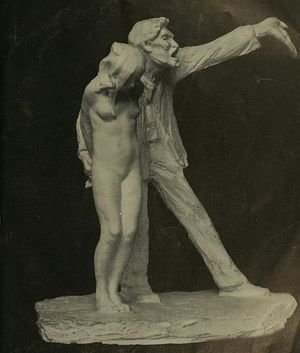
Template:Criminal law Pimping is sometimes operated like a business.[22] The pimp may have a bottom girl who serves as office manager, keeping the pimp apprised of law-enforcement activity and collecting money from the prostitutes.[23] Pimps recognize a hierarchy among themselves. In certain pimp strata, the least respected, or newer pimps, are the "popcorn pimps" and "wannabes". "Popcorn pimps" was a phenomenon which occurred among adolescent cocaine users of both sexes who utilized children younger than themselves to support their habits.[24] A pimp who uses violence and intimidation to control his prostitutes is called a "gorilla pimp", while those who use psychological trickery to deceive younger prostitutes into becoming hooked into the system are called "finesse pimps".[25] In addition, a prostitute may "bounce" from pimp to pimp without paying the "pimp moving" tax.[26]
Some pimps in the United States are also documented gang members, which causes concerns for police agencies in jurisdictions where prostitution is a significant problem.[27] Pimping rivals narcotic sales as a major source of funding for many gangs. Gangs need money to survive, and money equates to power and respect. While selling drugs may be lucrative for a gang, this activity often carries significant risk as stiff legal penalties and harsh mandatory minimum sentencing laws exist. However, with pimping, gang members still make money while the prostitutes themselves bear the majority of the risk. Pimping has several benefits to the gang that the pimp belongs to. These benefits include helping the gang recruit new members because the gang has women available for sex, and the money brought in by prostitution allows gang members to buy cars, clothes and weapons, all of which help to recruit younger members into the gang by increasing the reputation of the gang in the local gang subculture. The presence of gangs (and weapons and drugs) is a virtual guarantee when prostitutes are present, which is why many law-enforcement agencies advocate taking an aggressive stance against prostitutes. Many vice units work to ascertain if the prostitute they have arrested has a pimp, and if so, they pressure them to provide information about their pimp and the gang involved. This information can then be used to go after the more serious and violent offenders.[28]
Some pimp businesses have an internal structure – built around violence – for dealing with rule breakers. For example, some pimps have been known to employ a "pimp stick", which is two coat hangers wrapped together, in order to subdue unruly prostitutes.[23] A variation is a "pimp cane", used for similar purposes. Although prostitutes can move between pimps, this movement sometimes leads to violence. For example, a prostitute could be punished for merely looking at another pimp; this is considered in some pimp milieus to be "reckless eyeballing".[23] Violence can also used on customers, for example if the customer attempts to evade payment or becomes unruly with a prostitute.
Use of tattoos
Some pimps tattoo prostitutes as a mark of "ownership".[29] The tattoo will often be the pimp's street name or even his likeness. The mark might be as discreet as ankle tattoo, or blatant as a neck tattoo or large scale font across the prostitute's lower back, thigh, chest, or buttocks.[30]
Internet effect
Since the Internet became widely available, prostitutes increasingly use websites to solicit sexual encounters. This has bypassed the need for pimps in some contexts, while some pimps have used these sites to broker their sex workers.[31]
Criticism of portrayals
Some scholars and sex workers' rights advocates dispute portrayals of third-party agents as violent and extremely committed to a pimp subculture, finding them inaccurate exaggerations used to foster harmful policies.[32] For example, one study found that pimps tend to drift in and out of pimping, with some of their goals and identities classified as predominantly mainstream, some as predominantly outside of that mainstream, and some as a hybrid of conventional and non-conventional.[33]
Procuring and pornography
Attempts have been made in the U.S. to charge pornographic-film producers with pandering under state law. The case of California v. Freeman in 1989 is one of the most prominent examples where a producer/director of pornographic films was charged with pandering under the argument that paying porn actors to perform sex on camera was a form of prostitution covered by a state anti-pandering statute. The State Supreme Court rejected this argument, finding that the California pandering statute was not intended to cover the hiring of actors who would be engaging in sexually-explicit but non-obscene performances. It also stated that only in cases where the producer paid the actors for the purpose of sexually gratifying themselves or other actors, could the producer be charged with pandering under state law. This case effectively legalized pornography in the State of California.[34][35][36] In 2008, the New Hampshire Supreme Court issued a similar ruling (New Hampshire v. Theriault) which declared that producing pornography was not a form of prostitution under state law.[37]
Procuring in art
- Procuring in art
- Dirck van Baburen - The Procuress - Google Art Project.jpg
The Procuress by Dirck van Baburen, 1622
The procuress by Jan G. van Bronckhorst, 1636–1638
At the procuress, by Jan van Bijlert, second quarter of 17th century
In Salon of Rue des Moulins, (La Fleur blanche), by Henri de Toulouse-Lautrec, 1894
Notable pimps and madams
- Polly Adler
- Ah Toy
- Brenda Allen
- Sydney Biddle Barrows
- Scotty Bowers
- Belle Cora (Arabella Ryan)
- Kristin Davis
- Shirley Finn
- Heidi Fleiss (madam)
- Marguerite Gourdan (madam)
- Dennis Hof
- Xaviera Hollander
- Don "Magic" Juan
- Mary-Anne Kenworthy (madam)
- Isabel La Negra
- Enriqueta Martí
- Mother Damnable
- Elizabeth Needham
- Deborah Jeane Palfrey
- Justine Paris (madam)
- Grace Peixotto
- Lovisa von Plat
- Jurjentje Aukes Rauwerda
- Lindi St Clair (madam)
- Fillmore Slim
- Iceberg Slim
- Snoop Dogg[38]
- Sally Stanford
- Al Swearengen
- Anna Wilson (madam)
See also
Portal:Torture methods and devices
- American Pimp, a 1999 documentary by the Hughes Brothers consisting of first-person interviews with people involved in the pimping lifestyle in the U.S.
- Brothel
- Pandarus
- Prostitution
References
- ↑ (2018) Risky Business: Harlem Pimps' Work Decisions and Economic Returns 78, 12–27. Digital object identifier:10.1080/01639625.2018.1556863.
- ↑ Dank, Meredith. "Estimating the Size and Structure of the Underground Commercial Sex Economy in Eight Major US Cities", New York: Urban Institute, 2014.
- ↑ Stalans, Loretta and Mary A. Finn (2019). "Self-Narratives of Persistent Pimps and Those Anticipating Desistance: Emotions, Conventional Work, and Moral Profitability Calculus", Victims & Offenders, 14(5): 647-669.
- ↑ Characteristics of suspected human trafficking incidents, 2008–2010, https://bjs.gov/content/pub/pdf/cshti0810.pdf Accessed: 2013-08-07 (Publisher: Bureau of Justice Statistics)
- ↑ Marcus, Anthony (2014). Child Sex Trafficking: Toward an Agent Centered Approach. New York: Open Society Institute.
- ↑ Peter de Marneffe (1 April 2012). Liberalism and Prostitution. Oxford University Press, 18–. ISBN 978-0-19-972610-3.
- ↑ Canadian judge overturns brothel ban in Ontario, BBC. 29 September 2010
- ↑ Ontario Appeal Court strikes down ban on brothels, CBC News. 26 March 2012
- ↑ Canada's top court to hear prostitution challenge today |, https://www.ctvnews.ca/canada/canada-s-top-court-to-hear-prostitution-challenge-today-1.1323766 Accessed: 2013-11-05 (Publisher: Ctvnews.ca)
- ↑ Convention for the Suppression of the Traffic in Persons and of the Exploitation of the Prostitution of Others, https://www.ohchr.org/Documents/ProfessionalInterest/trafficpersons.pdf Accessed: 2014-04-29
- ↑ Decriminalisation integral to the fight against HIV, https://archive.today/20121208124200/http://www.abc.net.au/unleashed/4128420.html Accessed: 2012-07-13 (Publisher: Australian Broadcasting Corporation)
- ↑ U.N. Commission Calls for Legalizing Prostitution Worldwide, https://www.cnsnews.com/news/article/un-commission-calls-legalizing-prostitution-worldwide
- ↑ AIDS used as reason to legalize prostitutes, https://www.washingtontimes.com/news/2012/aug/2/aids-used-as-reason-to-legalize-prostitutes/
- ↑ Global Commission on HIV and the Law, https://web.archive.org/web/20150924030555/http://www.hivlawcommission.org/resources/report/FinalReport-Risks%2CRights%26Health-EN.pdf (Publisher: UNDP)
- ↑ 15.0 15.1 15.2 15.3 Jesse Sheidlower: A History of Pimping. What the word meant and what it means now. Slate.com, 11 February 2008
- ↑ Pennsylvania Gazette, Nov 7, 1765, transcription, http://www.smithsoniansource.org/display/primarysource/viewdetails.aspx?PrimarySourceId=1004 Accessed: 2013-06-17 (Publisher: Smithsonian Source)
- ↑ "Webster's College Dictionary", Random House, 2001
- ↑ Trice, Dawn Turner. "Scholarship is soured by unsavory name", Chicago Tribune, 27 April 2005.
- ↑ "Feet pimping: Local biz has plans for your feet", The Hook weekly, 20 September 2007. Retrieved on 26 September 2007.
- ↑ Brancati, Frederick L. (7 July 1989). The Art of Pimping 262, 89. Digital object identifier:10.1001/jama.1989.03430010101039.
- ↑ Classen, Albrecht (2010). Laughter in the Middle Ages and Early Modern Times: Epistemology of a Fundamental Human Behavior, Its Meaning, and Consequences, 462. ISBN 978-3110245479.
- ↑ Really Really Pimpin' in Da South, https://www.rottentomatoes.com/m/really_really_pimpin_in_da_south/ Accessed: 2015-10-05
- ↑ 23.0 23.1 23.2 U.S. v. Pipkins, https://web.archive.org/web/20120911145823/http://www.ca11.uscourts.gov/opinions/ops/200214306.pdf
- ↑ Pagliaro, Ann Marie and Pagliaro, Louis A. (1996). Substance abuse among children and adolescents: its nature, extent, and effects from conception to adulthood. New York: Wiley, p. 19. < ISBN:9780471580423 >.
- ↑ 378 F.3d 1281, 11th Cir., https://openjurist.org/378/f3d/1281/united-states-v-pipkins
- ↑ The Pimping Game, https://web.archive.org/web/20101113021452/http://www.wmich.edu/destinys-end/pimping%20game.htm (Publisher: Western Michigan University)
- ↑ Females and Gangs: Sexual Violence, Prostitution, and Exploitation, https://www.ngcrc.com/ngcrc/proffem2.htm Accessed: 11 December 2019 (Publisher: National Gang Crime Research Center)
- ↑ Prostitution & Gangs. Techniques for going after violent offenders, https://lawofficer.com/archive/prostitution-gangs/
- ↑ Urbina, Ian. "Running in the Shadows (part 2 of 2): For Runaways on the Street, Sex Buys Survival", The New York Times, 27 October 2009, p. 1. Retrieved on 20 November 2010.
- ↑ Rowe, Claudia. "No way out: Teen girls sell bodies in Seattle", June 26, 2008.
- ↑ Poulsen, Kevin. "Pimps Go Online to Lure Kids Into Prostitution", February 25, 2009.
- ↑ The Honest Courtesan: Bogeymen, https://maggiemcneill.wordpress.com/2012/07/27/bogeymen/
- ↑ (2019) Harlem Pimps' Accounts of their Economic Pathways and Feelings of Insiderness and Outsiderness 7, 69–94.
- ↑ California v. Freeman, https://caselaw.findlaw.com/us-supreme-court/488/1311.html Accessed: 2013-11-05 (Publisher: Caselaw.lp.findlaw.com)
- ↑ First Amendment Lawyer - Creating Adult Content Outside California, http://www.firstamendment.com/content_outside_ca.php3 Accessed: 2013-11-05 article status: dead (Publisher: Firstamendment.com)
- ↑ faq: part 11: legal issues, http://www.rame.net/faq/part11.html#xtocid21960 Accessed: 2013-11-05 (Publisher: rame.net)
- ↑ Timmins, Annmarie. "Offer to tape sex nullifies conviction: 'It's not prostitution but speech, court says'", Concord Monitor, December 5, 2008. Retrieved on October 26, 2015. Archived from the original on June 20, 2010.
- ↑ America's Most Lovable Pimp, https://www.rollingstone.com/news/story/12676363/cover_story_americas_most_lovable_pimp/print
External links
Template:Commons category-inline
Chat rooms • What links here • Copyright info • Contact information • Category:Root
